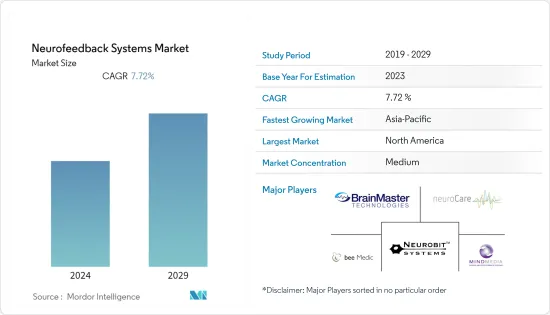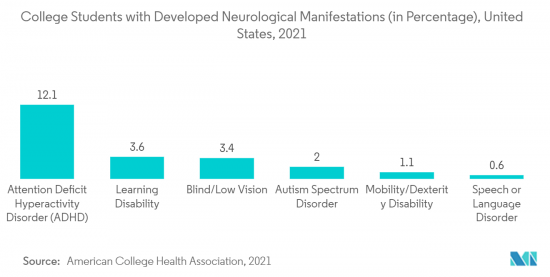PUBLISHER: Mordor Intelligence | PRODUCT CODE: 1406021

PUBLISHER: Mordor Intelligence | PRODUCT CODE: 1406021
Neurofeedback Systems - Market Share Analysis, Industry Trends & Statistics, Growth Forecasts 2024 - 2029

The Neurofeedback Systems Market size is expected to grow from USD 1.3 billion in 2024 to USD 1.8 billion by 2029, at a CAGR of 7.72% during the forecast period (2024-2029).
During the COVID-19 pandemic, the mental state of individuals was significantly affected, and consequently, many suffered from different psychiatric and neuropsychiatric disorders. For instance, according to the WHO update, in March 2022, in the first year of the COVID-19 pandemic, the global prevalence of anxiety and depression increased by 25%. Furthermore, according to an article published by Einstein in April 2022, the harmful effect of the pandemic on mental health not only existed during the pandemic but also in the post-pandemic era. These neurological manifestations of post-COVID complications were treated by rehabilitation, oxygen therapy, and immunotherapy, and that significantly reduced anxiety and depression. Besides, the COVID-19 pandemic provided an opportunity to develop innovative methods to address the global burden of the increasing number of neurological manifestations. For instance, according to an article published by PLoS One, in July 2022, neurofeedback was feasible for the treatment of post-COVID neurological complications as well as for studying their inter-relatedness. Hence, the COVID-19 pandemic had a significant impact on the market growth.
The increasing burden of brain dysfunctions and increasing technological advancements towards brain monitoring are the factors that drive market growth. For instance, according to the WHO update, in September 2022, more than 55 million people were living with dementia worldwide, and there are nearly 10 million new cases every year. It also stated that Alzheimer's disease is the most common form of dementia and may contribute to 60%-70% of the cases. Furthermore, according to an article published by Global Burden of Diseases, Injuries, and Risk Factors, in January 2022, the number of people with dementia worldwide are likely to increase by 166%, from about 57.4 million in 2019 to 152.8 million people by 2050. Therefore, the increasing prevalence of such brain dysfunction across the global population is expected to drive market growth over the forecast period.
Besides, various technological advancements and innovative product launches in this domain also boost market growth. For instance, in October 2021, Interaxon Inc. launched the second generation of its popular EEG meditation and sleep headband, Muse S. This updated plush brain-sensing headband uses real-time neurofeedback to help learn the art of meditation for falling asleep. Such development is expected to drive market growth over the forecast period.
Hence, the neurofeedback systems market is anticipated to grow due to the abovementioned factors over the forecast period. However, high costs and time-consuming processes will likely restrain the market growth.
Neurofeedback Systems Market Trends
Attention Deficit Hyperactivity Disorder (ADHD) is Expected to be a Significant Market Contributor Over the Forecast Period
Attention Deficit Hyperactivity Disorder (ADHD) segment is one of childhood's most common neurodevelopmental disorders. It is usually first diagnosed in childhood and often lasts into adulthood. Patients who have ADHD, particularly children, may have trouble paying attention, controlling impulsive behaviors, or maybe being overly active. The major factors fueling the segment's growth are the increasing focus on the R&D of neurofeedback therapies and devices along with the growing burden of ADHD worldwide. For instance, according to the CDC update, in September 2021, 8.8% of people had been diagnosed with ADHD in the past few years. Moreover, as per the above source, 13.6 million visits to doctors' offices were made with attention deficit disorder as the primary diagnosis. Thus, such prevalence indicates that the demand for neurofeedback systems for the research and treatment of ADHD is likely to contribute to market growth.
Moreover, the increasing focus on R&D is leading to the development of effective neurofeedback systems, thereby supporting market growth. For instance, as per an October 2021 update by the National Institute for Health and Care (NIHR) Maudsley Biomedical Research Centre (BRC) 2022, the Medical Research Council funded USD 1.59 million for a larger trial of 100 children with ADHD to compare fMRI-neurofeedback to a placebo that is not related to their brain activity. The work also led to new collaborations locally and with the National Institute of Mental Health and Dresden University. The team secured funding (approximately USD 2.45 million from NIHR, Action Medical Research) to trial other brain-based therapies in ADHD, including different types of non-invasive brain stimulation treatments such as transcranial direct current stimulation and stimulation of the trigeminal nerve, which is responsible for sensations in the face.
Thus, the above-mentioned factors are likely to drive the segment growth during the forecast period.

North America Expected to Hold a Significant Share in the Market with Similar Trends over the Forecast Period
North America is expected to hold a significant growth of this market which is largely attributed to the rising prevalence of target diseases in this region. For instance, as per the Alzheimer's Disease Facts And Figures 2023 report, the population of Americans aged 65 years and older is projected to grow from 58 million in 2021 to 88 million by 2050. The above source also stated that in 2023 about 2.4 million people with Alzheimer's dementia are likely to be 85 years of age or older and are projected to account for 33% of all people with Alzheimer's dementia, and this number is projected to reach to 6.7 million people by 2060, accounting for about 48% of all people 65 years of age and older with Alzheimer's dementia. As the risk of dementia rises with age, it is anticipated that both the number and percentage of people with Alzheimer's or other dementias is likley to increase in the coming years. Thus, this high burden of Alzheimer's disease is projected to create demand for neurofeedback systems, thereby contributing to the market growth of the market in the region.
Moreover, frequent strategic initiatives are also expected to drive the market. For instance, in June 2022, New Beginnings Sexual Assault Support Services received the Kentucky Colonels Grant 2022, which led to the purchase of NeurOptimal Advanced Brain Training System machines for use in office locations. NeurOptimal neurofeedback training allows users to unconsciously self-regulate brain activity in real-time using electroencephalography (EEG) monitoring and feedback. Such an initiative is expected to drive market growth in the region.
Hence, all the above factors are likely to contribute to makret growth in North America Over the Forecast Period.
Neurofeedback Systems Industry Overview
The neurofeedback systems market is moderately competitive in nature due to the presence of companies operating globally and regionally. The competitive landscape includes an analysis of a few international and local companies that hold market shares and are well-known, including Brainmaster Technologies Inc., Mind Media, NeuroCare Group GmbH, Neurobit Systems, and BEE Medic, among others.
Additional Benefits:
- The market estimate (ME) sheet in Excel format
- 3 months of analyst support
TABLE OF CONTENTS
1 INTRODUCTION
- 1.1 Study Assumptions and Market Definition
- 1.2 Scope of the Study
2 RESEARCH METHODOLOGY
3 EXECUTIVE SUMMARY
4 MARKET DYNAMICS
- 4.1 Market Overview
- 4.2 Market Drivers
- 4.2.1 Increasing Burden of Brain Disorders
- 4.2.2 Increasing Technological Advancements Towards Brain Monitoring
- 4.3 Market Restraints
- 4.3.1 High-Cost and Time-Consuming Neurofeedback Sessions
- 4.4 Porter's Five Forces Analysis
- 4.4.1 Bargaining Power of Suppliers
- 4.4.2 Bargaining Power of Buyers/Consumers
- 4.4.3 Threat of New Entrants
- 4.4.4 Threat of Substitute Products
- 4.4.5 Intensity of Competitive Rivalry
5 MARKET SEGMENTATION
- 5.1 By Application
- 5.1.1 Attention Deficit Hyperactivity Disorder (ADHD)
- 5.1.2 Pain Management
- 5.1.3 Insomnia
- 5.1.4 Anxiety Disorder
- 5.1.5 Other Applications
- 5.2 Geography
- 5.2.1 North America
- 5.2.1.1 United States
- 5.2.1.2 Canada
- 5.2.1.3 Mexico
- 5.2.2 Europe
- 5.2.2.1 Germany
- 5.2.2.2 United Kingdom
- 5.2.2.3 France
- 5.2.2.4 Italy
- 5.2.2.5 Spain
- 5.2.2.6 Rest of Europe
- 5.2.3 Asia-Pacific
- 5.2.3.1 China
- 5.2.3.2 Japan
- 5.2.3.3 India
- 5.2.3.4 Australia
- 5.2.3.5 South Korea
- 5.2.3.6 Rest of Asia-Pacific
- 5.2.4 Middle East and Africa
- 5.2.4.1 GCC
- 5.2.4.2 South Africa
- 5.2.4.3 Rest of Middle East and Africa
- 5.2.5 South America
- 5.2.5.1 Brazil
- 5.2.5.2 Argentina
- 5.2.5.3 Rest of South America
- 5.2.1 North America
6 COMPETITIVE LANDSCAPE
- 6.1 Company Profiles
- 6.1.1 Brainmaster Technologies Inc.
- 6.1.2 BEE Medic
- 6.1.3 Neurobit Systems
- 6.1.4 NeuroCare Group GmbH
- 6.1.5 Thought Technology Ltd
- 6.1.6 Mind Media BV
- 6.1.7 Wearable Sensing
- 6.1.8 Mitsar Co. Ltd
- 6.1.9 Myndlift
7 MARKET OPPORTUNITIES AND FUTURE TRENDS




